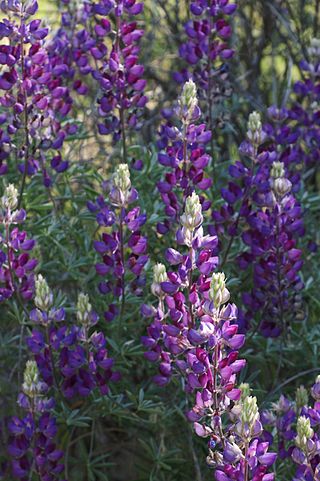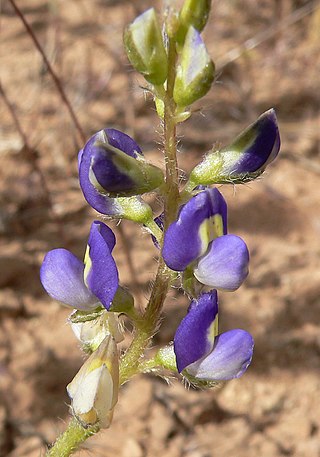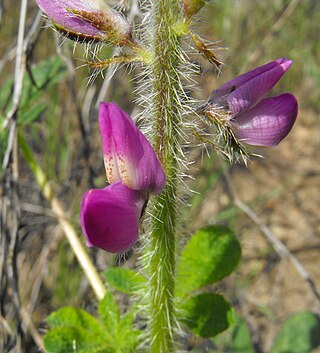
Eriogonum fasciculatum is a species of wild buckwheat known by the common names California buckwheat and flat-topped buckwheat. Characterized by small, white and pink flower clusters that give off a cottony effect, this species grows variably from a patchy mat to a wide shrub, with the flowers turning a rusty color after blooming. This plant is of great benefit across its various habitats, providing an important food resource for a diversity of insect and mammal species. It also provides numerous ecosystem services for humans, including erosion control, post-fire mitigation, increases in crop yields when planted in hedgerows, and high habitat restoration value.

Lupinus nanus, the sky lupine, field lupine, dwarf lupin, ocean-blue lupine or Douglas' annual lupine, is a species of lupine native to the western United States. It is found natively in California, Nevada, and on Steens Mountain in eastern Oregon. It tends to grow on slopes and in open or disturbed areas below 1300 meters.

Lupinus bicolor is a species of lupine known as the miniature lupine, Lindley's annual lupine, pigmy-leaved lupine, or bicolor lupine.
Astragalus bicristatus is a species of milkvetch known by the common names crested milkvetch and two-crested milkvetch. It is endemic to southern California, where it grows in the coniferous forests of the San Gabriel and San Bernardino Mountains of the Transverse Ranges.

Lupinus albifrons, silver lupine, white-leaf bush lupine, or evergreen lupine, is a species of lupine (lupin). It is native to California and Oregon, where it grows along the coast and in dry and open meadows, prairies and forest clearings. It is a member of several plant communities, including coastal sage scrub, chaparral, northern coastal scrub, foothill woodland, and yellow pine forest.
Lupinus adsurgens is a species of lupine known by the common name Drew's silky lupine. It is native to the Sierra Nevada and coastal mountain ranges of northern California and southern Oregon, where it grows in forest and other mountain habitat. It is a perennial herb growing 20–60 centimetres (7.9–23.6 in) in height. Each palmate leaf is made up of 6 to 9 leaflets each up to 5 centimetres (2.0 in) long. The herbage is hairy and silvery or gray-green in color. The inflorescence is up to 23 centimetres (9.1 in) long, bearing flowers just over a centimeter long. The flower is pale pink or purple to yellowish with a white or yellow patch on the banner. The fruit is a silky-haired legume pod 2 to 4 centimetres (1.6 in) long containing 3 to 6 seeds.

Lupinus affinis is a species of lupine known by the common name fleshy lupine. It is native to the California Coast Ranges from the San Francisco Bay Area north, and into southern Oregon, where it is an uncommon member of the flora in several areas.

Lupinus arbustus is a species of lupine known by the common name longspur lupine. It is native to western North America from British Columbia to California to Utah, where it grows in several types of habitat, including sagebrush and forests. This is a perennial herb growing erect to a maximum of 70 centimetres tall. It is sometimes hairy in texture. Each palmate leaf is made up of 7 to 13 leaflets each up to 7 centimetres long. The inflorescence is up to 18 centimetres long, bearing whorls of flowers each up to 1.4 centimetres long. The calyx of sepals around the base of the corolla has a knoblike spur at the back. The flower corolla is white to yellow to various shades of purple or pink. The fruit is a hairy legume pod 2 or 3 centimetres long. There are several subspecies.

Lupinus argenteus is a species of lupine known by the common name silvery lupine. It is native to much of western North America from the southwestern Canadian provinces to the southwestern and midwestern United States, where it grows in several types of habitats, including sagebrush, grassland, and forests. This is a perennial herb growing erect to heights anywhere between 10 centimetres (3.9 in) and 1.5 metres (4.9 ft). It is sometimes silvery-hairy in texture and sometimes nearly hairless. Each palmate leaf is made up of 5 to 9 leaflets each up to 6 centimetres long. They are narrow and linear in shape, under a centimetre wide. The inflorescence bears many flowers, sometimes arranged in whorls. The flower is 5 millimetres (0.20 in) to 14 millimetres (0.55 in) long and purple, blue, or whitish in color. The banner, or upper petal, of the flower may have a patch of white or yellow. The fruit is a hairy legume pod up to 3 centimeters long containing several beanlike seeds. The plant is an important food source for butterflies. It also attracts birds and hummingbirds.

Lupinus benthamii is a species of lupine known by the common name spider lupine.

Lupinus cervinus is a species of lupine known by the common name Santa Lucia lupine. It is endemic to the Santa Lucia Mountains in the Central Coast Ranges in California, where it is an uncommon member of the flora in the mountain forests. This is a hairy gray-green perennial herb growing up to 30–70 centimetres (12–28 in) tall. The erect stem is surrounded by clusters of spreading leaves. Each palmate leaf is made up of 4 to 8 leaflets up to 8 centimetres (3.1 in) long and 3 centimetres (1.2 in) wide, which is wider than the leaflets of most lupines. The inflorescence bears many flowers, sometimes in whorls, each between 1 centimetre (0.39 in) and 2 centimetres (0.79 in) long. The flower is often bright pink, but may be shades of blue to nearly white. There is often a yellow patch on the banner. The fruit is a hairy legume pod up to 6 centimetres (2.4 in) long.

Lupinus chamissonis is a species of lupine known by the common name Chamisso bush lupine. It is endemic to California, where it is known from most of the length of the coastline. It grows in sand dunes and other immediate coastal habitat.
Lupinus elmeri is an uncommon species of lupine known by the common names Elmer's lupine and South Fork Mountain lupine. It is endemic to California, where it is known only from a few scattered occurrences in the northernmost slopes of the North Coast Ranges, in Trinity county.

Lupinus flavoculatus is a species of lupine known by the common name yelloweyes, or yellow-eyed lupine.

Lupinus hirsutissimus is a species of lupine known by the common names stinging annual lupine or stinging lupine. It is native to the coastal mountains of Baja California and Southern California as far north as the San Francisco Bay Area. It grows on dry mountain slopes, including areas that have recently burned, and chaparral and woodlands habitats.

Lupinus leucophyllus is a species of lupine known by the common name velvet lupine. It is native to western North America, where it grows in many types of mountain, prairie, and plateau habitat. It is a robust, branching, erect perennial herb growing up to 90 centimetres (35 in) tall. Each palmate leaf is divided into 7 to 11 leaflets up to 7 centimetres (2.8 in) long. The herbage is coated in white woolly fibers and stiff hairs. The inflorescence is dense raceme of many flowers, each around a centimeter long. The flower is purple in color, fading brown, the patch on the banner petal yellow or brownish. The pointed sepals and the back of the banner are hairy to woolly in texture.
Lupinus saxosus is a species of lupine known by the common name rock lupine. It is certainly native to eastern Washington, eastern Oregon, and the northeast corner of California,where it grows in sagebrush and other habitat. It may also be native to Idaho and Nevada.

Lupinus stiversii is a species of lupine known by the common names harlequin annual lupine and harlequin lupine. The plant was named for Army physician Dr. Charles Austin Stivers, who first collected it in 1862 near Yosemite.

Lupinus sericeus is a species of flowering plant in the legume family known by the common name silky lupine or Pursh's silky lupine. It is native to western North America from British Columbia to Arizona and east to Alberta and Colorado.

Lupinus lepidus, the Pacific lupine, prairie lupine or dwarf lupine is a perennial herbaceous plant in the pea family (Fabaceae) endemic to western North America. Many varieties have been described, several of which are considered separate species by some authorities.
















